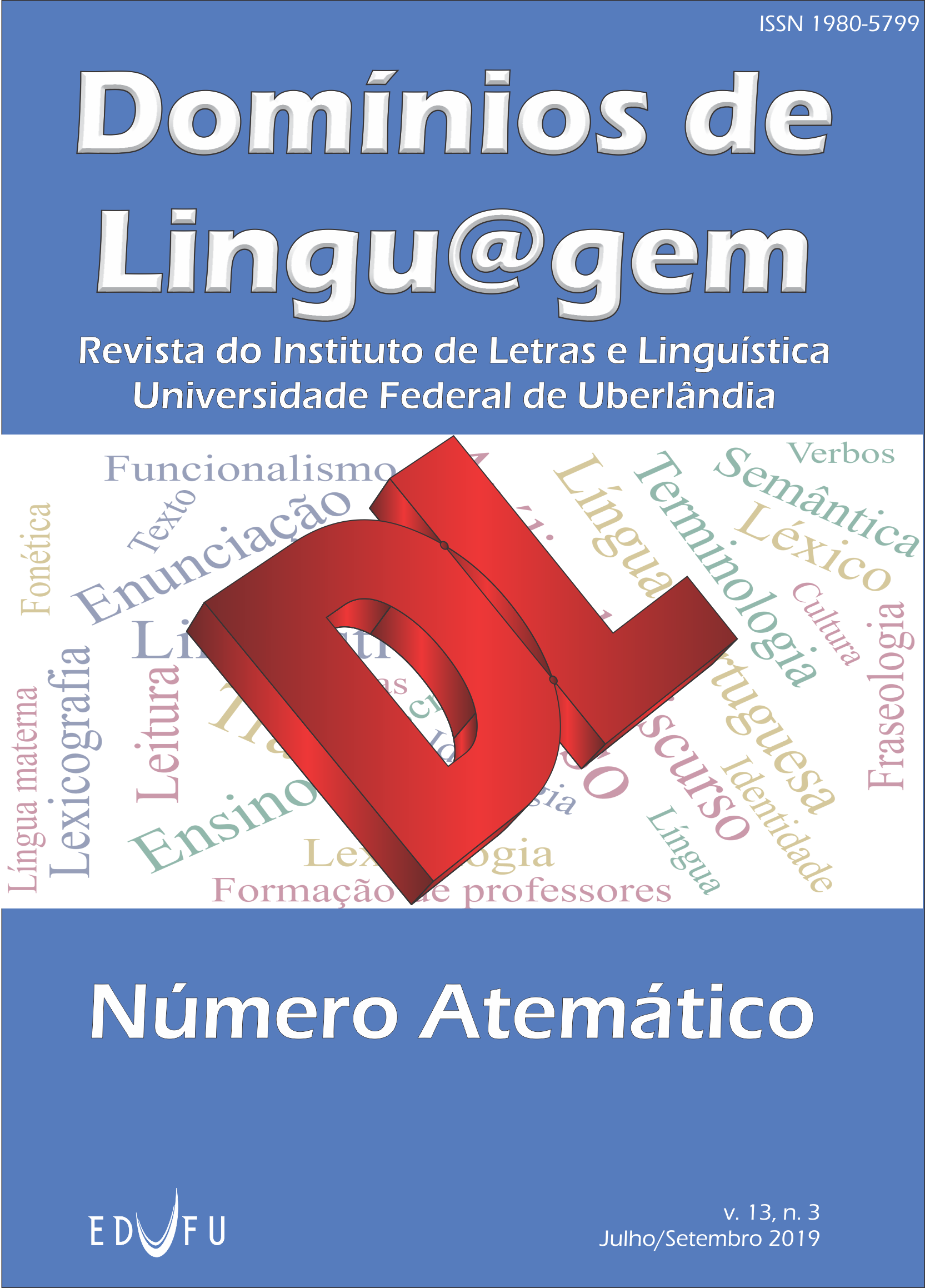Sintagmas preposicionados nucleados por com como predicados de sentenças nominais na história do Português Brasileiro de Pernambuco
DOI:
https://doi.org/10.14393/DL39-v13n3a2019-2Palabras clave:
Português Brasileiro, Sentenças Copulares, Sintagmas PreposicionaisResumen
As sentenças nominais (ou copulares) ocorrem com os dois verbos cópulas do Português Brasileiro, ser e estar. Em relação à predicação nessas sentenças, o predicado seleciona seu sujeito. Assim, os sintagmas preposi-cionais predicados selecionam seu sujeito e, a depender da preposição núcleo, alteram o sentido do sintagma que os segue. Neste trabalho, procurou-se des-crever os contextos sintáticos, pouco estudados em termos descritivos e teóricos, em que os predicados nucleados pela preposição com aparecem combina-dos a ser e estar. Neste estudo, lançando mão de corpora, verificamos uma maior ocorrência desse sintagma preposicional com o verbo estar. Assim, foram analisa-dos, quantitativamente, através do mé-todo indutivo, documentos – manuscritos e impressos – correspondentes ao período do século XVIII ao XX, do estado de Pernambuco.
Descargas
Métricas
Citas
BENVENISTE, É. Être et avoir dans leur function linguistique. In: BENVENISTE, É. Problèmes de linguistique générale. Paris: Gallimard, 1966. DOI https://doi.org/10.7202/500389ar
BERG, M. B. O Comportamento Semântico-Lexical das Preposições do Português do Brasil. Tese (Mestrado em Linguística), Universidade Federal de Minas Gerais, Belo Horizonte, 2005. DOI https://doi.org/10.14393/19834071.2016.36163
CARLSON, G. Reference to Kinds in English. Tese de Doutorado. University of Massachusetts at Amherst, 1977.
CHOMSKY, N. Knowledge of Language: Its Nature, Origin and Use. Greenwood Publishing Group. New York: Praeger, 1986.
ILARI, R. et al. A Preposição. In: ILARI, R. (org.). Gramática do português culto falado no Brasil: volume IV: palavras de classe fechada. São Paulo: Contexto, 2015.
DUARTE, I. A família das construções inacusativas. In: MIRA MATEUS, M. H. et al. Gramática da Língua Portuguesa (5ª edição, revista e aumentada). Lisboa (Editorial Caminho – Colecção Universitária / Série LINGUÍSTICA), 2003. p. 507-548.
GALLEGO, Á. J.; URIEGEREKA, J. Estar = Ser + X. Borealis — An International Journal of Hispanic Linguistics, v. 5, n. 1, p. 123-156, 2016.
LABOV, W. Principles of linguistic change: internal factors. Oxford: Blackwell, 1994.
MATTOS E SILVA, R. V. Observações sobre a variação no uso dos verbos ser, estar, haver, ter no galego-português ducentista. Estudos lingüísticos e literários, v. 19, p. 253-285, 1997.
MATTOS E SILVA, R. V. O Português Arcaico: Fonologia, Morfologia e Sintaxe. São Paulo: Contexto, 2006.
MOLINA, Silvia Gumiel. Sobre las diferencias entre ser y estar. El tipo de predicado y el tipo de sujeto. Redele: Revista Electrónica de Didáctica ELE, n. 13, jun. 2008.
MORO, A. The raising of predicates. Cambridge: CUP, 1997.
POGGIO, R. M. G. F. Aspectos da gramaticalização na história das preposições do latim ao português. Revista do GELNE, v. 4, n. 2, p. 1-7, 2002.
RECH, N. F. Verbos de reestruturação no Português Brasileiro. Revista do GEL, São Paulo, v. 8, n. 1, p. 165-182, 2011.
STOWELL, T. What Was There Before There Was There. Papers from the Fourteenth Regional Meeting of the Chicago Linguistic Society. Chicago: Chicago Linguistic Society. p. 458–471, 1978.
Descargas
Publicado
Cómo citar
Número
Sección
Licencia
Domínios de Lingu@gem utiliza la licencia Creative Commons (CC) CC BY-NC-ND 4.0, preservando así la integridad de los artículos en un ambiente de acceso abierto. La revista permite al autor conservar los derechos de publicación sin restricciones.









